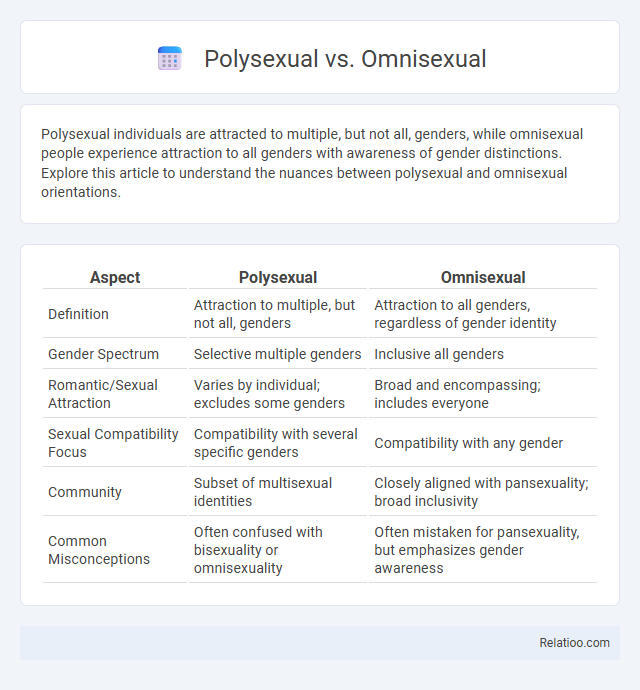Polysexual individuals are attracted to multiple, but not all, genders, while omnisexual people experience attraction to all genders with awareness of gender distinctions. Explore this article to understand the nuances between polysexual and omnisexual orientations.
Table of Comparison
| Aspect | Polysexual | Omnisexual |
|---|---|---|
| Definition | Attraction to multiple, but not all, genders | Attraction to all genders, regardless of gender identity |
| Gender Spectrum | Selective multiple genders | Inclusive all genders |
| Romantic/Sexual Attraction | Varies by individual; excludes some genders | Broad and encompassing; includes everyone |
| Sexual Compatibility Focus | Compatibility with several specific genders | Compatibility with any gender |
| Community | Subset of multisexual identities | Closely aligned with pansexuality; broad inclusivity |
| Common Misconceptions | Often confused with bisexuality or omnisexuality | Often mistaken for pansexuality, but emphasizes gender awareness |
Introduction to Polysexuality and Omnisexuality
Polysexuality refers to attraction to multiple, but not all, genders, distinguishing it from omnisexuality, which involves attraction to all genders without preference. Both identities fall under the broader umbrella of sexual orientation, describing the spectrum of ways people experience attraction beyond traditional labels. Understanding your orientation can help clarify your personal identity and foster deeper self-awareness.
Defining Polysexual: What Does It Mean?
Polysexual refers to an attraction to multiple, but not all, genders, distinguishing it from omnisexuality which encompasses attraction to all genders. Unlike generalized sexual orientation categories, polysexuality specifies a more selective range within the gender spectrum. Understanding polysexuality involves recognizing its unique position between bisexuality and omnisexuality, highlighting diverse and multifaceted sexual orientations.
Defining Omnisexual: Understanding the Term
Omnisexual refers to a sexual orientation characterized by attraction to all genders, with an awareness and appreciation of gender diversity, distinguishing it from polysexual which excludes some genders. Unlike general sexual orientation terms that cover broad attraction patterns, omnisexual individuals experience attraction across the entire gender spectrum while often recognizing gender as a significant factor in their attraction. Understanding omnisexuality involves recognizing the nuanced acknowledgment of gender identity in attraction, setting it apart from bisexuality and pansexuality.
Key Differences Between Polysexual and Omnisexual
Polysexual individuals are attracted to multiple, but not all, genders, while omnisexual people experience attraction to all genders without preference. Both terms fall under the broader umbrella of sexual orientation, which describes enduring patterns of emotional, romantic, or sexual attraction. Understanding the distinctions between polysexual and omnisexual orientations can help you better identify and respect diverse experiences of gender and attraction.
Similarities and Overlapping Aspects
Polysexual, omnisexual, and broader sexual orientation categories all describe diverse patterns of attraction beyond traditional binaries, emphasizing fluidity and inclusivity. You may notice overlaps where polysexual individuals are attracted to multiple, but not all, genders, while omnisexual people experience attraction to all genders with recognition of gender differences. Each orientation contributes to a nuanced understanding of sexual diversity, highlighting the spectrum rather than rigid classifications.
Common Myths and Misconceptions
Polysexuality involves attraction to multiple, but not all, genders, while omnisexuality encompasses attraction to all genders with awareness of gender differences, contrasting with the broader umbrella of sexual orientation that includes various patterns of attraction. Common myths suggest polysexual and omnisexual identities are interchangeable or less valid than more recognized orientations, which overlooks the nuance and personal significance behind each term. Your understanding benefits by recognizing these distinctions, debunking misconceptions that simplify or erase the complexity of diverse sexual orientations.
Identity and Self-Expression
Polysexuality involves attraction to multiple, but not all, genders, offering a unique spectrum of identity that highlights selective gender attraction. Omnisexuality encompasses attraction to all genders, emphasizing a more inclusive self-expression without gender preference. Understanding your sexual orientation, whether polysexual, omnisexual, or otherwise, is crucial for authentic identity recognition and empowered self-expression.
Inclusion in the LGBTQ+ Community
Polysexual and omnisexual orientations both represent diverse attractions to multiple genders, enhancing inclusion within the LGBTQ+ community by affirming non-binary experiences. Polysexual individuals are attracted to several, but not all, genders, while omnisexual people experience attraction to all genders with an awareness of gender distinctions. Recognizing these orientations alongside broader sexual orientations fosters a more inclusive environment that respects varied gender identities and expressions.
Representation in Media and Culture
Polysexual and omnisexual identities represent distinct sexual orientations characterized by attraction to multiple genders, each deserving nuanced media representation to foster inclusivity. Polysexuality involves attraction to several, but not all, genders, whereas omnisexuality signifies attraction to all genders with awareness of gender differences, highlighting the necessity for accurate portrayal in cultural narratives. Increasing diverse representation of these orientations in media challenges traditional labels, promotes understanding, and validates the experiences of underrepresented sexual minorities within the broader LGBTQ+ spectrum.
Supporting Polysexual and Omnisexual Individuals
Supporting polysexual and omnisexual individuals involves recognizing and validating the distinctiveness of their sexual orientations within the LGBTQ+ spectrum. Polysexuality refers to attraction to multiple, but not all, genders, while omnisexuality includes attraction to all genders with awareness of gender diversity. Creating inclusive environments requires tailored resources, affirming language, and community spaces that respect the nuances of both identities to foster acceptance and mental well-being.

Infographic: Polysexual vs Omnisexual
 relatioo.com
relatioo.com